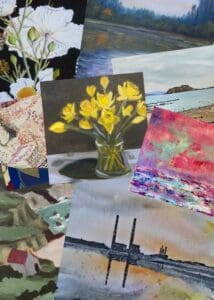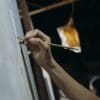Art fairs are a vibrant platform for artists to showcase their work, connect with buyers, and gain exposure in the art world. For many artists, participating in these events can be a significant opportunity to advance their careers. However, preparation and strategy are crucial for making the most out of these events. This comprehensive guide will walk you through practical advice on booth setup, pricing strategies, engaging with potential buyers, and follow-up tactics to maximize your sales and exposure at art fairs.
Booth Setup: Creating a Captivating Display
-
- Space Efficiency: Utilize your space effectively. Use vertical space with shelves or hanging displays to maximize the area.
- Flow: Create a logical flow for visitors to navigate through your booth. Avoid clutter and ensure there’s enough room for visitors to view your work comfortably.
- Visual Appeal: Use a cohesive color scheme and professional displays that complement your art. Your booth should attract attention and invite visitors in.
- Design Your Booth Layout Your booth is your canvas; it should reflect your style and make a memorable impression. Consider the following when designing your layout:
- Lighting Proper lighting is essential for highlighting your work. Invest in quality lighting to ensure your pieces are well-lit and stand out. Consider adjustable LED lights that you can direct onto your artwork to enhance colors and details.
- Display Materials Invest in high-quality display materials such as frames, easels, or stands that complement your work. Ensure they are sturdy and can handle the weight of your pieces without risk of damage.
Pricing Strategies: Setting the Right Value
- Research and Compare Before setting prices, research similar works by other artists in the same market. Analyze their pricing strategies to gauge where your work fits. Look at artists with similar styles and experience levels to establish a baseline.
- Pricing Structure Develop a pricing structure based on factors such as material costs, time invested, and market demand. Consider tiered pricing for different sizes or types of artwork.Remember to factor in the cost of participation in the art fair, including booth fees and travel expenses.
- Offer Payment Options Providing multiple payment options can increase sales. Accept credit/debit cards, checks, and even digital payment methods like PayPal or mobile payment apps.Use Square or PayPal for reliable payment processing solutions.
Engaging with Potential Buyers: Building Relationships
- Approachability Be friendly and approachable. Smile, make eye contact, and be ready to engage with visitors. Your attitude can significantly influence a potential buyer’s experience.
- Articulate Your Story Share the story behind your work. Explain your creative process, inspirations, and techniques. Buyers are often drawn to the narrative and personal connection behind an artwork.
- Interactive Elements Consider incorporating interactive elements into your booth, such as live demonstrations or workshops. These can draw visitors in and provide a deeper understanding of your work.
- Collect Contact Information Use a guestbook or digital signup form to collect contact information from interested visitors. This will allow you to follow up with potential buyers and keep them informed about future exhibitions or sales.
Follow-Up Tactics: Maximizing Sales and Exposure
- Send Thank-You Notes Follow up with a thank-you email or note to visitors who expressed interest in your work. Personalized messages can help build relationships and encourage future purchases.Use Mailchimp or Constant Contact for email marketing.
- Update Your Website and Social Media Post about your participation in the art fair on your website and social media channels. Share photos, visitor interactions, and any sales you made. This not only updates your followers but also keeps you visible in the art community.Use hashtags like #ArtFair, #ArtistLife, #ArtSales, and #ArtExhibition to increase your reach on social media platforms like Instagram, Facebook, and Twitter.
- Evaluate and Reflect After the fair, take time to evaluate what worked well and what could be improved. Analyze your sales, booth traffic, and visitor feedback to refine your approach for future events.
Conclusion
Participating in art fairs can be a transformative experience for artists. By carefully preparing your booth setup, establishing effective pricing strategies, engaging with potential buyers, and following up diligently, you can maximize your sales and exposure. Remember, each fair is a learning opportunity that can help you grow as an artist and expand your reach in the art world.
*For collaborations, art features, or inquiries, please contact us at [email protected]. Don’t forget to follow us on Instagram, Facebook, Twitter.
Disclaimer: The views and opinions expressed in this article do not necessarily reflect the official policy or position of Irish Artmart.
Irish Artmart – Your Gateway to Artistic Excellence.




